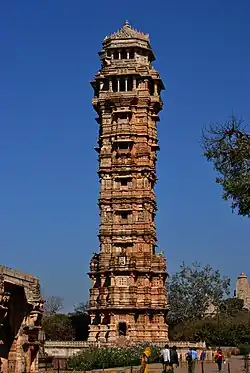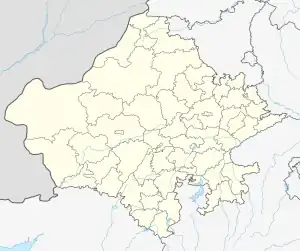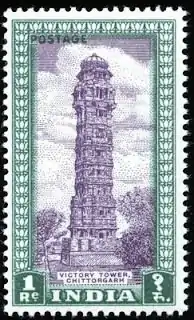Vijaya Stambha
The Vijaya Stambha is an imposing victory monument located within Chittor Fort in Chittorgarh, Rajasthan, India. The tower was constructed by the Hindu Rajput king Rana Kumbha of Mewar in 1448 to commemorate his victory over the army of Malwa led by Mahmud Khalji in the Battle of Sarangpur. The tower is dedicated to Hindu God Vishnu.[1][2]
| Vijaya Stambha | |
|---|---|
 Vijaya Stambha (Tower of Victory) | |
 Location within India  Vijaya Stambha (Rajasthan) | |
| Alternative names | Victory Tower |
| General information | |
| Type | Tower |
| Location | Chittorgarh, Rajasthan, India |
| Coordinates | 24.887870°N 74.645157°E |
| Completed | 1448[1] |
| Height | 37.19 m (122 ft)[1] |
| Technical details | |
| Floor count | 9[1] |
| Design and construction | |
| Architect(s) | Sutradhar Jaita[1] |
Inscriptions
The inscribed slabs in the uppermost storey containing a detailed genealogy of the rulers of Chittaur and their deeds is ascribed to Rana Kumbha court scholar, Atri and his son Mahesh. The names of the architect, Sutradhar Jaita and his three sons who assisted him, Napa, Puja, and Poma, are carved on the fifth floor of the tower.[1]
The Vijaya Stambha is a remarkable example of religious pluralism practised by the Rajputs. The topmost story features an image of the Jain Goddess, Padmavati.[3][4]
See also
References
- "Chittaurgarh Fort, Distt. Chittaurgarh". Archaeological Survey of India. Archived from the original on 21 October 2007. Retrieved 15 April 2015.
- Chandra, Satish (2004). Medieval India: From Sultanat to the Mughals-Delhi Sultanat (1206-1526) - Part One. Har-Anand Publications. p. 224. ISBN 9788124110645.
- Chittorgarh, Shobhalal Shastri, 1928, pp. 64-65
- Ali, M. Athar (January 1990). "Encounter and Efflorescence: Genesis of the Medieval Civilization". Social Scientist. 18 (1/2): 20. JSTOR 3517324.
External links
 Media related to Vijaya Stambha at Wikimedia Commons
Media related to Vijaya Stambha at Wikimedia Commons
